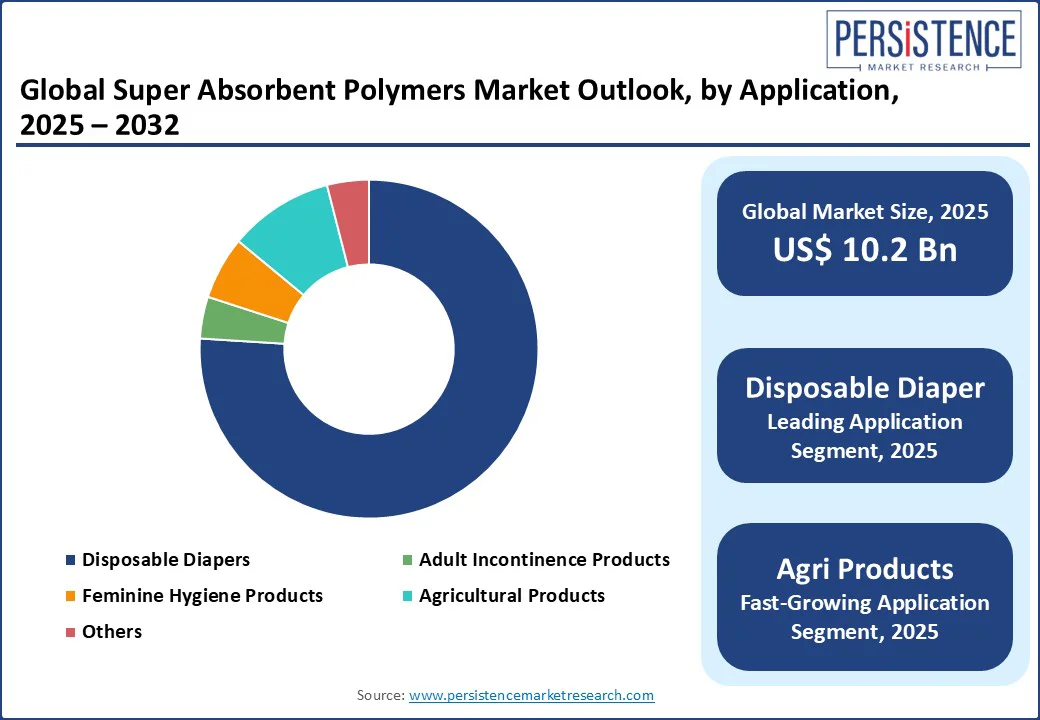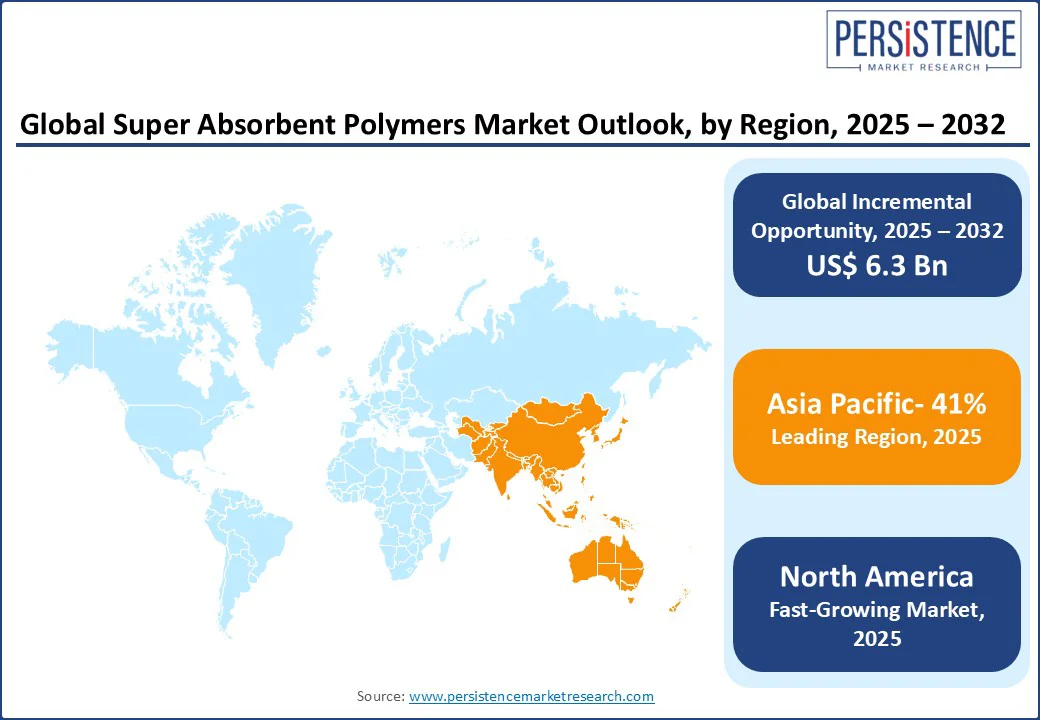ID: PMRREP3258| 302 Pages | 19 Aug 2025 | Format: PDF, Excel, PPT* | Chemicals and Materials

The global Super absorbent polymers market size is likely to value at US$ 10.2 Bn in 2025, and reach US$ 16.5 Bn by 2032, growing at a CAGR of 7.1% during the forecast period from 2025 to 2032.
The rise in global population, coupled with growing awareness of hygiene and sustainable agricultural practices, further fuels market expansion, particularly in regions with advanced manufacturing and retail infrastructures. Super absorbent polymers, known for their exceptional ability to absorb and retain large volumes of liquid, are gaining traction due to their versatility, cost-effectiveness, and applicability across diverse industries.
Key Industry Highlights
|
Global Market Attribute |
Key Insights |
|
Super absorbent polymers Market Size (2025E) |
US$10.2 Bn |
|
Market Value Forecast (2032F) |
US$16.5 Bn |
|
Projected Growth (CAGR 2025 to 2032) |
7.1% |
|
Historical Market Growth (CAGR 2019 to 2024) |
6.0% |
The escalating demand for personal hygiene products, such as disposable diapers, adult incontinence products, and feminine hygiene items, is a primary driver of the global Super absorbent polymers market. With global population growth projected to reach 8.5 Bn by 2030, according to the United Nations, the need for hygiene products is surging, particularly in emerging economies.
Rising consumer awareness of hygiene, coupled with government initiatives such as India’s Swachh Bharat Mission, promotes the adoption of SAP-based products in healthcare and household settings. The aging population in developed regions, such as the U.S., further drives demand for incontinence products, with the U.S. Census Bureau reporting a growing elderly demographic. The increasing focus on hygiene in healthcare settings and rising consumer awareness in developing nations further propel the adoption of SAP-based products, ensuring sustained market growth through 2032.
Environmental concerns and high production costs pose significant challenges to the Super absorbent polymers market. The production of superabsorbent polymers, particularly sodium polyacrylate, involves energy-intensive processes and petrochemical-based raw materials, which eventually contribute to a high carbon footprint.
Additionally, the non-biodegradable nature of traditional SAPs raises environmental concerns, particularly in regions with stringent waste management regulations, such as the European Union, where single-use plastics face increasing scrutiny. Limited recycling infrastructure for SAP-based products, such as diapers, further restricts market growth. Smaller manufacturers also face challenges due to the high capital investment required for advanced production facilities, limiting their ability to compete with established players such as BASF SE and Nippon Shokubai.
The rising demand for sustainable agricultural practices presents significant opportunities for Super absorbent polymers, particularly in water-scarce regions. Super absorbent polymers are increasingly used in agriculture to enhance soil water retention, reduce irrigation frequency, and improve crop yields.
In regions such as the Middle East and Africa, where water scarcity affects 60% of agricultural land, per FAO data, SAPs are being adopted to optimize water usage in crops such as wheat and maize.
Companies such as Sumitomo Seika and LG Chem have introduced bio-based SAPs, aligning with global sustainability trends and government initiatives, such as India’s Jal Shakti Abhiyan, which promotes water conservation. The development of biodegradable SAPs also offers manufacturers a chance to tap into premium markets, addressing environmental concerns and driving innovation through 2032.

Asia Pacific, the leading region, holds approximately 41% market share in 2025, propelled by rapid industrialization, rising disposable incomes, and increasing adoption of SAPs in personal hygiene and agriculture in China and India. In 2024, China’s super absorbent polymers market grew significantly, driven by its massive diaper manufacturing industry, while India witnessed an increase in use of super absorbent polymers in agriculture, supported by government initiatives such as the Pradhan Mantri Krishi Sinchayee Yojana. Companies such as LG Chem and Nippon Shokubai are expanding production to meet regional demand.
North America is the fastest-growing region, driven by robust demand for personal hygiene products and advanced manufacturing infrastructure in the U.S. and Canada. The region’s aging population, coupled with high consumer awareness of hygiene, fuels demand for SAP-based products such as adult incontinence pads. Companies such as BASF SE and Evonik Industries dominate, leveraging extensive R&D to develop high-performance SAPs. Urbanization and a strong retail network, including giants such as Walmart, further drive market growth.
Europe, the second fastest-growing region, is driven by stringent environmental regulations and high demand for sustainable SAPs in personal hygiene and medical applications. Germany and France lead, with companies such as BASF SE and Evonik Industries investing in bio-based SAPs to align with the EU’s Circular Economy Action Plan. The region’s advanced healthcare sector and growing focus on eco-friendly products further boost market growth.

The global Super absorbent polymers market is highly competitive, with key players such as BASF SE, LG Chem, Nippon Shokubai Co., Ltd., and Sumitomo Seika Chemicals Co., Ltd. dominating through extensive product portfolios and global distribution networks. Regional players such as Yixing Danson Technology focus on localized offerings, particularly in the Asia Pacific. Companies are investing in R&D to develop biodegradable and high-performance SAPs, addressing environmental concerns and enhancing market share through sustainable innovation.
The super absorbent polymers market is projected to reach US$ 10.2 Bn in 2025.
Rising demand for personal hygiene products and expanding applications in agriculture are the key market drivers for the global Super absorbent polymers market.
The super absorbent polymers market is poised to witness a CAGR of 7.1% from 2025 to 2032.
The growing adoption of super absorbent polymers in agriculture for water retention solutions is the key market opportunity of the Super absorbent polymers market.
BASF SE, LG Chem, Nippon Shokubai Co., Ltd., and Sumitomo Seika Chemicals Co., Ltd. are a few key market players.
|
Report Attribute |
Details |
|
Historical Data/Actuals |
2019 - 2024 |
|
Forecast Period |
2025 - 2032 |
|
Market Analysis Units |
Value: US$ Bn/Mn, Volume: As Applicable |
|
Geographical Coverage |
|
|
Segmental Coverage |
|
|
Competitive Analysis |
|
|
Report Highlights |
|
|
Customization and Pricing |
Available upon request |
By Polymer Type
By Application
By Region
Delivery Timelines
For more information on this report and its delivery timelines please get in touch with our sales team.
About Author